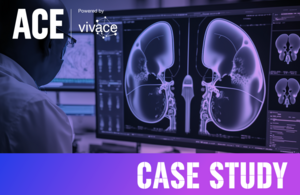Developing an AI tool to recognise serious kidney illness
ACE worked with kidney doctors to develop a method to detect acute kidney injury.

Kidneys are critical to staying alive. When they fail, organ support through dialysis treatment is needed to manually take over the kidneys’ work of cleaning the blood so life is sustained.
Acute kidney injury (AKI) is a type of kidney disease that is common among those who are hospitalised. It can occur for many reasons including dehydration and infection and comes on very quickly. This can make it difficult to ensure an appropriate treatment bed is ready, as dialysis can only be carried out in a kidney or intensive care unit.
The Accelerated Capability Environment (ACE) was asked to explore possible ways of detecting AKI before it became critical and went on to develop a proof of concept (PoC).
Predicting support needs
While not everyone who gets AKI will need dialysis, it is currently not possible to predict those that will before severe complications occur, at which point it becomes a medical emergency. Medics have to wait for markers of life-threatening symptoms such as a high potassium level, lots of fluid in the body and lungs, and blood becoming acidic and toxic-laden to develop before dialysis can be started.
University Hospitals Leicester (UHL) kidney doctors Haresh Selvaskandan and Gang Xu applied for an NHS Digital grant to explore how artificial intelligence (AI) and machine learning could be used to predict who might need kidney support.
When it was awarded, ACE was commissioned by what was then the NHS AI Lab Skunkworks to help develop a tool that can identify more than 24 hours in advance the 5% to 10% of people who are already suffering AKI and at higher risk of needing an intensive care stay or kidney support.
Better accurate forecasting would mean acute care beds can be readied. It would also mean lower stress for patients as they can be prepared for dialysis, which often involves a line being inserted into the neck, earlier in a non-emergency setting.
Early warning predictor
UHL is one of the largest acute care trusts in England with over 1,700 beds and more than 200 patients a day suffer from sudden changes in kidney function. Of these, 40 are admitted to intensive care every month and 50 to 60 referred for speciality care such as dialysis.
UHL has been using electronic record collection for patients since 2017, and available data includes blood test results, medication data, and observations such as blood pressure, heart rates and oxygen levels, as well as previous conditions logged by GPs. A de-anonymised and de-identified dataset of past patients was created by UHL’s data team and sent to ACE on an encrypted pipeline.
ACE, working with Roke from its Vivace supplier community, set out to understand if a tool could be built to ingest and analyse this data and identity patterns of early deterioration.
In just 15 weeks – a speed not seen before by the customer – a PoC was developed for a 24 to 48 hour advance predictive model. This was built on a codebase used by Google’s DeepMind AI model but was modified for the available data, as well as building in explainability to clarify how decisions are reached.
Dr Selvaskandan said:
Gang and I were excited by it because it was a great PoC. It showed that we can build a tool which can be clinically useful, which will help with future grant applications to investigate the value of tools like this further.
Working with ACE was absolutely fantastic, because in the NHS we weren’t used to Agile working, everything takes a long time.
ACE was very good at helping us adapt to Agile working, and facilitating discussions and decisions between the technical team from Roke and the clinical team we represented from UHL.
The PoC work was presented at a kidney world congress, and then at UK Kidney Week, a yearly event which is the centre of all kidney medicine in the UK. Here it won an award for best AKI research work presented. The work has also been published as an abstract in a kidney health journal called Kidney International Reports.
The next step is to build this into a manuscript, which can be peer reviewed for feedback. This will help inform how the model can be further developed and improved, which will enable the UHL team to apply for more grant-based funding. For example, the PoC is currently better at identifying those patients who definitively won’t go on to develop AKI than those who will, because it was built on a dataset where only 1.5% of patients developed AKI.